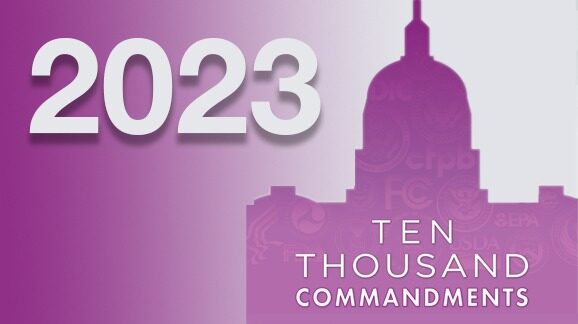Chapter 14: Government Accountability Office Database on Regulations
The federal government’s reports and databases on regulations serve different purposes:
- The Federal Register details and depicts the aggregate number of proposed and final rules—both those that affect the private sector and those that deal with internal government procedures or programs—and numerous notices and presidential documents.
- The Unified Agenda presents agency regulatory priorities and provides details about the number of rules at various stages in the regulatory pipeline, rules with economically significant effects, and rules affecting small businesses and state and local governments.
The 1996 Congressional Review Act is intended to increase rulemaking accountability. It requires that agencies submit rules to both houses of Congress and to the Government Accountability Office (GAO), and the GAO submit reports to Congress on the major ones—those with annual estimated costs of $100 million or more.
Owing to such “Reports on Major Rules,” which are prepared and maintained by the GAO in an online database, one can more readily observe (a) which of the thousands of final rules that agencies issue each year are major and (b) which departments and agencies are producing the major rules. However, many final rules are not being properly submitted to the GAO and to Congress as required under the CRA.
Major rules can add burdens, reduce them, delay their implementation, or set rates and standards for major government programs like Medicaid. Major guidance documents are also subject to the CRA, but are rarely presented to the GAO or to Congress.
The CRA provides Congress a window of 60 legislative days in which to review a received rule and pass a resolution of disapproval should it choose. Despite the issuance of thousands of rules since the CRA’s passage, including dozens of major ones, before 2017 only one had been rejected (a Department of Labor rule on workplace repetitive-motion injuries in 2001). Currently, just 20 have been overturned by CRA procedures.
The GAO database contains 87,014 rules through December 31, 2022. By contrast, as noted, the Federal Register and National Archives repository indicate 99,429 rules since the CRA’s passage through 2022. The database contains 1,784 reports on major rules through year-end 2022.
Table 9 depicts the number of final major rule reports issued by the GAO regarding agency rules from 2003 through calendar year 2022. With the caveat that the GAO database may not yet include all relevant rules from 2022, 76 major rules appear in the database for 2022 as of this writing. This number is likely to change because, for example, the tally of 98 recorded for 2021 has now increased in the current search to 129. Both of these counts are significant drops from the 140 seen in 2020, which exceeded the prior high marks of 105 in 2016 and 100 in 2010 since GAO began these CRA-required tabulations.
There are several dozen GAO reports on major rules each year. Reporting on all aspects of rulemaking can improve. The GAO counts are presented for context and completeness, despite fluctuations, to be able to usefully compare them with other metrics, such as the major rule and economically significant tallies found in the twice-yearly Unified Agenda, as well as significant rules in the Federal Register.

Several categories of large rules have a bewildering nomenclature encompassing such terms as rules, significant rules, major rules, economically significant rules, guidance, and more. For example, an economically significant rule is major, but a major rule is not necessarily economically significant. That means there should be fewer economically significant rules than major ones. Both economically significant and major rules qualify as significant. Table 10 depicts numbers of each category for the past seven years.
Note that some economically significant rule counts from the Unified Agenda periodically appear larger than the GAO’s count of major or significant rules in some instances. The different explanations follow:
- Calendar and fiscal years do not align.
- Rules are not being reported to the GAO but are being noted at OMB.
- Independent agency rules may appear under different categorizations in various databases.
- Budget and transfer rules are reported differently.
Legislation or an executive order to systematize nomenclature could help bring greater clarity, reconcile recordkeeping across various government databases, and subject independent agencies to greater oversight by Congress and the public.
Regarding Table 9’s GAO-based compilation, Obama issued 675 major rules, compared with George W. Bush’s 492, both over eight years. This presentation covers calendar years, so Bush’s eight years contain the final weeks of Clinton’s presidency before Bush’s inauguration, and Obama’s first year includes the Bush administration’s final weeks.
George W. Bush averaged more than 61 major rules annually during his eight years in office. Obama averaged slightly more than 84. Trump issued an average of almost 86 major rules annually, some of which were deregulatory. Biden’s preliminary major rule total is 205, for an average of 103.
